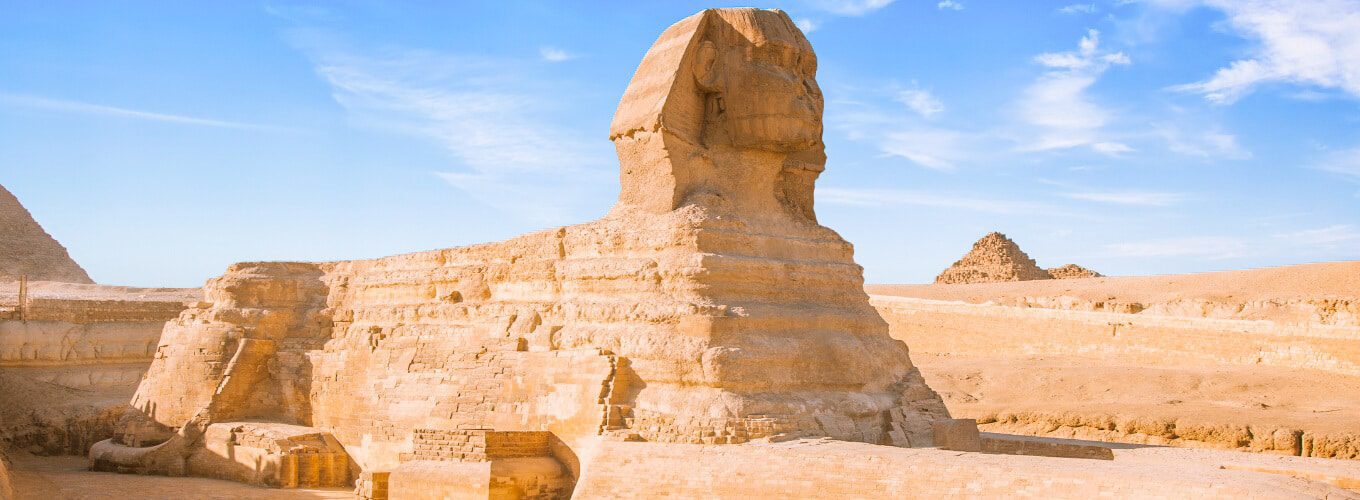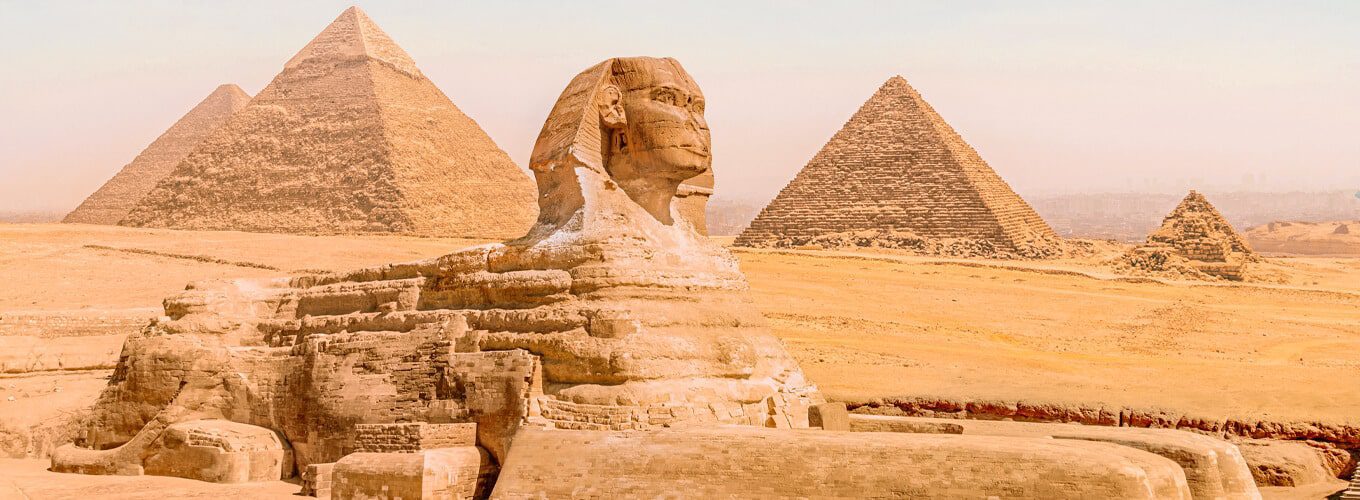The Giza Necropolis is a complex of ancient Egyptian tombs, temples, and pyramids located on the west bank of the Nile River, just outside Cairo. It is one of the world’s most famous and iconic archaeological sites and is home to the Great Pyramid of Giza, the only surviving member of the Seven Wonders of the Ancient World.
Uncover the mysteries of Egypt’s ancient wonders with our Egypt Pyramids Tour Packages. Secure your spot on this historical journey today!

Necropolis of Giza Facts
- The plateau is in the city of Giza, which is in the plain of the same name, and it is a few kilometers from the capital and on the left bank of the Nile.
- This group of monuments is the world’s most well-known picture of Egypt.
- The area between the necropolis and the rest of the city has some of the best evidence of Ancient Egypt. This kind of thing is called a “testimony.”
- Behind the Sphinx are the three most famous pyramids: the Pyramid of Cheops, the Pyramid of Khufu (or Great Pyramid), which is the only one of the seven ancient wonders of the world that is still standing today, the Pyramid of Khafre, which is the northernmost Pyramid, and the Pyramid of Menkaure, which is the southernmost Pyramid.
- People thought that the sides of the pyramids looked like the sun and that the Pyramid itself was a way to get to the sky.
Giza Necropolis in Egypt
There are a lot of tombs, mastabas, and cemeteries. There are also a few buildings for consorts, private tombs, and the graves of high officials and other royal family members.The “Village of the Craftsmen,” where the people who built the pyramids lived, and the Giza necropolis, which was created for them, were found in the same place. This village has two pyramid tombs, one southeast of the other.
People looking down on the above area might think that only the northern part of the plateau has old buildings, but this is only because the three pyramids are so giant. Many more tombs and graves have been found farther west than it looks. The workers’ village and cemeteries make the necropolis much more critical than it seems to have been.
The ancient history of the Giza Necropolis
Egyptian pharaohs built these huge pyramids around 4,500 years ago to bury their dead because they were so big. People think the shape of the Pyramid has something to do with the sun. The edges of the Pyramid would look like the sun’s rays spreading out over the earth, and its shape would be used to reach the sky.
Each dynasty built its necropolis, so it was rare for more than one to use the same one. The third and fourth dynasties were buried in Giza, while the first and second dynasties were buried in Umm El-Qa’ab.
People from the third dynasty lived in Egypt in a place called Saqqara. They were buried north of Saqqara in Abousir. Since the beginning of time, the first dynasty has used the necropolis of Saqqara. The old empire also used it, and no rule applies.
Let’s look at how the necropolis was used between 2550 and 2450 at its best. We can see that each tomb has a pyramid that serves as a tomb, a wall that protects the Pyramid, a temple near the Pyramid, a paving, a temple at the bottom, and one or more cemeteries.
Create lasting memories with our Cairo Holiday Packages. Take action and reserve your Cairo adventure now!
What is in the Giza Necropolis?
1- Khufu’s Pyramid
The largest and oldest Pyramid in the complex is called “The Horizon of Cheops.” This is what the ancient Egyptians called it.
The Great Pyramid used to have a smooth stone covering over its base, which is why you can see it today.
Around the base, you can still see some of the original rocks.
The underground chamber and the Queen’s Chamber, and the King’s Chamber were found inside the Pyramid of Khufu. The underground room was on the lowest level of the Pyramid.
Scholars are still interested in how the Pyramid was built because it took 23 years, and about 100,000 large blocks of concrete were dug out of the ground each year. Each block weighed about 2.5 tonnes and was moved to the building site and stacked to a height of 147 meters.
Many ruling dynasties in the centuries studied the Pyramid of Khufu after it was built. This wasn’t so much to keep the monument in good shape as to get to any treasures inside it.
In any case, Khufu’s bodies and grave goods were never found and probably ended up in the hands of tomb robbers of the time.
2- Pyramid of Khafra
Ancient people called this Pyramid the “Great Chefren.” It was built by Khufu’s son, who took over as ruler after his father.
Even though it was built on a smaller scale than the Pyramid of Khufu, the Pyramid of Chephren, which stands 136 meters tall, looks like the tallest building in the complex.
This is because the walls are tilted more, and the Pyramid was built on top of a rocky “pedestal” about 10 meters high.
One thing that makes this Pyramid stand out is that it still has the thin stone slabs that were initially on top of all pyramids.
3- Menkaure’s Pyramid
Menkaure’s Pyramid, The last Pyramid built on the Plain of Giza, was called “Divine is Mycerinus” by the ancient Egyptians.
With a height of “only” 66 meters, this Pyramid is shorter than the others and shows a mistake in how it was built.
It was built with more giant stone blocks than the other buildings, but they were put together in a much less planned way. After Mycerinus died too soon, the original plan had to be changed.
The more common white limestone was used instead of the expensive red granite from Aswan.
4-Giza’s Great Sphinx

The Sphinx of Giza, part of Chefren’s tomb, is on a stone platform next to the ramp leading to the temple downriver from Chefren. The dead pharaoh was made ready for the afterlife in this place.
The statue is an impressive lion with a human face. It is 73.5 meters long, 20.2 meters high, and 19.3 meters wide. The Sphinx was carved from a block of rock to represent and protect the Pharaoh Chefren.
The statue is in bad shape because it was built with low-quality stone and has been damaged by sand and weather.
Legends about it, like the one that says there are secret rooms hidden under the Sphinx’s body, add to the great interest in this old building.
Step into history with our Classical Egypt Tours. Secure your booking now for an unforgettable journey through time!
The Mysteries of the Pyramids of Giza
On top of the great numbers we just talked about, we can’t forget to talk about some of the mysteries of the Pyramids of Egypt:
Following the stars that make up the constellation Orion, the Pyramid of Khufu is perfectly lined up with the other two, the pyramids of Chephren and Menkaura, or Mycerinus.
Alpha Draconis, the polar star, is shown down into the Pyramid.
It is thought that this is because Osiris, the Egyptian god of rebirth, was linked to the pyramids of Giza.
Recent research shows that if you divide the base of the Great Pyramid of Giza by twice its height, you get 3.14, the value of the pi-greek number.
There is also a pi-greek in the length and perimeter ratio in the King’s Chamber. Simply amazing.
How the pyramids of Egypt were built has been a mystery for almost 5,000 years.
Even older is the Great Sphinx. It has often been called the eighth wonder of the ancient world, and new research suggests it could be up to 10,000 years old.

Theories about the rise of the Giza Necropolis
- It was easy to make blocks with lime, saltpeter, and sand.
- The blocks were easy to make on the spot because they were made from dolomitic limestone. A lot of men needed to move a lot of blocks.
- The blocks were in baskets that they carried. After that, the blocks were put in wooden molds to dry.
- If this were to happen, people would have to do much less work, and the blocks would be in the right place.
- The ancient Egyptians were very good at getting and moving huge pieces of stone that weighed more than 300 tonnes, like granite obelisks.
- You can still see the famous unfinished obelisk at an old quarry near Aswan, which weighs more than a thousand tonnes.
- This is a great place to get information on how to get granite stones.
Also, people think that the pyramids of Khufu and Khafre had pits next to them that held (or probably born) a wooden funeral boat.
Everyone knows that the Sphinx, this fascinating figure from mythology, is a massive sculpture from the middle of the 16th century BC.
It was built by Pharaoh Khafre (Chephren), who also created the second Pyramid. The Sphinx is a temple with a statue that looks much like the one in Khafra.
It is impossible to know whether the face was Khufu or Khafra. Even now, scientists have different ideas, even though most agree that it was Khafre. People like Khufu point out that he doesn’t have a fake beard, an essential part of the other pharaoh’s look. People who say that the Sphinx statue is of Khafre show that this part is new and couldn’t have been added after the study of the Sphinx.

